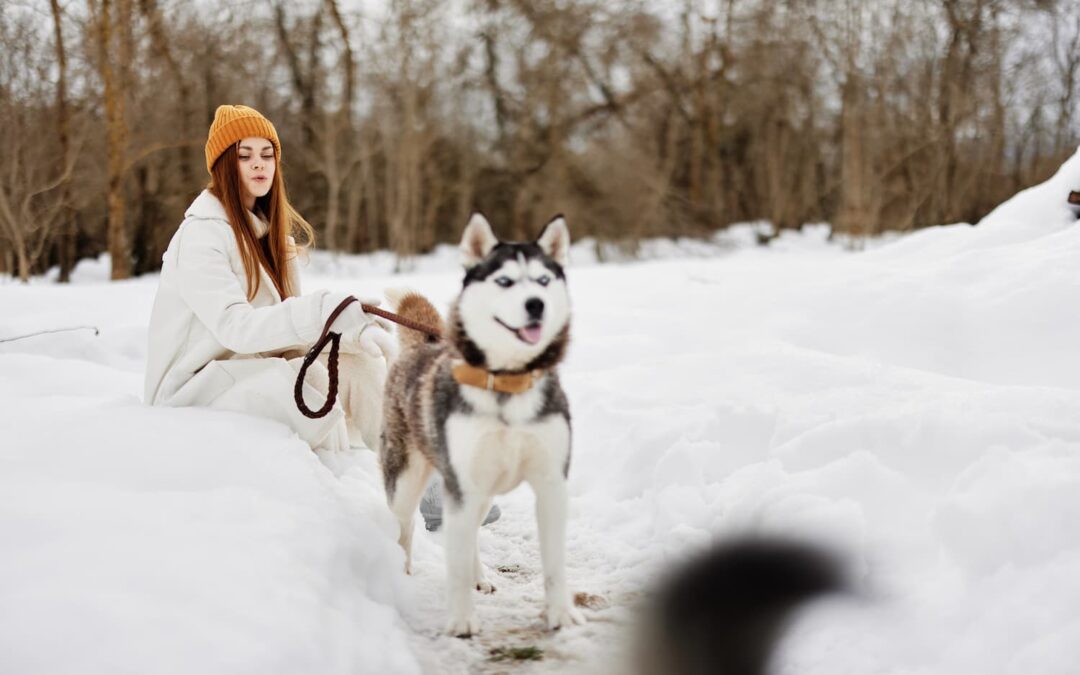As the colder winter months roll in, many of us notice more stiffness in our joints, and our senior pets feel it too. If you’ve seen your older dog or cat having a harder time getting up in the morning, limping after a walk, or moving more slowly, it could be due to joint pain made worse by the cold. In Bloomington, where winters are often harsh, it’s essential to pay close attention to the needs of your senior pets, particularly when it comes to their joint health. Thankfully, with a few thoughtful steps, you can help your furry companions stay comfortable and mobile, even during the coldest part of the year.
How Cold Weather Affects Senior Pet Joints
Cold temperatures can worsen joint pain and stiffness in senior pets, particularly those with arthritis. As the weather gets colder, the synovial fluid that lubricates joints thickens, making movement more difficult. Reduced activity during the winter months can also lead to increased stiffness, as regular movement is necessary to keep joints flexible. Additionally, cold weather causes muscles to tighten, putting extra strain on joints, making winter a challenging time for senior pets with joint issues.
The Science Behind Joint Stiffness in Colder Temperatures
When temperatures drop, joint fluid thickens, reducing mobility and increasing discomfort for senior pets. Blood flow is directed toward the body’s core to maintain warmth, reducing circulation to the extremities, which makes joint tissues stiffer. Cold weather also leads to less activity, which worsens joint stiffness, making it harder for senior pets to move when they become inactive for long periods.
Arthritis and Cold Weather
Pets with arthritis are especially affected by cold weather, as it increases inflammation, pain, and stiffness in the joints. The cold also causes muscles to tighten, placing additional stress on already inflamed joints. Senior pets with arthritis, particularly in cold and damp areas like Bloomington, experience more discomfort and restricted movement, leading to further stiffness and pain.
Cold Weather Joint Care for Pets in Bloomington
In Bloomington’s freezing winters, senior pet owners need to take extra precautions to protect their pet’s joint health. Providing warmth, keeping pets active, and considering joint supplements are essential strategies for managing cold-weather joint pain. With the right care, senior pets can remain comfortable and mobile, even in the colder months.
Signs of Winter Joint Stiffness in Older Dogs and Cats
It’s not always easy to tell when your pet is in pain, especially because animals often try to hide their discomfort. However, there are some telltale signs of joint pain and stiffness that you can look out for during the colder months. By being observant, you can catch early signs of discomfort and take steps to help your pet before the pain becomes too severe.
Here are some common signs that your senior dog or cat may be struggling with joint stiffness during winter:
- Difficulty getting up from lying down: If your pet seems to struggle when rising from a resting position, this is a strong indicator of joint stiffness.
- Limping or favoring one leg: You might notice your dog limping or putting less weight on one leg, especially after resting or waking up.
- Moving more slowly than usual: Pets with joint pain may walk more slowly or seem hesitant to engage in activities they used to enjoy.
- Reluctance to climb stairs or jump onto furniture: If your pet hesitates or avoids climbing stairs or jumping onto their favorite spot, joint pain could be the cause.
- Stiffness after rest: It’s common for pets with joint pain to be stiff after long periods of rest, especially during the winter months when they may be more sedentary.
Catching signs of joint pain early is essential for helping senior pets before the discomfort worsens. Since cold weather can intensify arthritis and other joint issues, monitoring your pet’s movement and behavior during winter is key to ensuring their comfort and mobility.
Senior Dog and Cat Arthritis in the Winter Months
Arthritis is a leading cause of joint pain in senior pets, and cold weather worsens the symptoms, making movement harder. Conditions like hip dysplasia or joint injuries can also be aggravated by winter conditions, emphasizing the need for proactive care.
What to Do If You Notice These Signs
If your pet shows signs of joint pain, consider providing an orthopedic bed, joint supplements, and keeping them warm. A veterinary consultation is essential for assessing joint health and creating a treatment plan. South Hyland Pet Hospital offers tailored care to manage joint pain and ensure your senior pet’s comfort during the winter months.
Simple Ways to Help Your Senior Pet Stay Comfortable in Winter
Winter may be hard on your pet’s joints, but the good news is there are plenty of ways to help them stay comfortable and happy. Here are some tips to ease your senior pet’s joint pain and support their overall health during the winter months:
- Keep Your Pet Warm: Provide a warm, cozy space with an orthopedic or heated bed to reduce joint stiffness. Use blankets and keep the bed away from cold drafts to help relax muscles and ease joint pain.
- Moderate Exercise: Regular, gentle movement like short walks or indoor play keeps joints flexible and prevents stiffness. Avoid icy surfaces to prevent strain or injury.
- Joint Supplements: Glucosamine, chondroitin, and omega-3 supplements reduce inflammation and support joint health. Always consult your vet before starting any supplements. If you’re considering adding a joint supplement to your pet’s routine, visit our online pharmacy to explore veterinarian-recommended options. It’s always a good idea to consult with your veterinarian before starting any new supplements to ensure they’re the right fit for your pet’s needs.
- Create a Safe Space: Use ramps or steps to help your pet avoid stairs and jumping, reducing joint strain.
- Massage and Gentle Stretching: Massage and light stretching improve blood flow and relieve tight muscles. Consult your vet for guidance on proper techniques.
When to Seek Help from a Veterinarian
While these at-home strategies can be incredibly effective, sometimes your pet’s joint pain may require professional intervention. If you notice that your pet’s pain is severe or if the symptoms don’t improve with your care at home, it’s time to schedule a visit to the veterinarian. At South Hyland Pet Hospital, we can provide a thorough evaluation of your pet’s joint health and recommend appropriate treatments.
Recognizing When Joint Pain Becomes Severe
Signs that joint pain has worsened include persistent limping, difficulty standing or lying down, reluctance to move, or changes in mood and behavior. Early intervention can prevent further pain and improve your pet’s quality of life.
Available Treatments for Joint Pain in Senior Pets
Depending on your pet’s condition, treatments may include:
- Pain Management: Medications to reduce inflammation and pain.
- Joint Injections: Corticosteroid or hyaluronic acid injections for direct joint relief.
- Cold Laser Therapy: Non-invasive therapy to reduce inflammation and promote healing.
- Physical Rehabilitation: Exercises to strengthen joints and improve mobility.
- Weight Management: Reducing weight to relieve joint strain.
Keep Your Senior Pet Happy and Healthy This Winter
Winter can be hard on senior pets, but with extra care, you can help them stay comfortable. Watch for signs of joint pain, keep them warm, and ensure they get gentle exercise. If you’re concerned about your pet’s joint health, call South Hyland Pet Hospital at (952) 884-1868 to schedule an appointment or visit our online pharmacy for joint supplements and products to keep your pet healthy and happy this winter.
FAQs About Cold Weather Joint Care for Senior Pets
- How can I tell if my pet’s joint pain is worsening in the winter?
If your pet is limping, moving slower than usual, or having trouble getting up after resting, these are signs their joint pain may be worsening. Stiffness is often more noticeable in the morning or after inactivity. If symptoms get worse, consult your veterinarian.
- Are joint supplements really effective for senior pets?
Yes, joint supplements like glucosamine, chondroitin, and omega-3 fatty acids can be very beneficial for senior pets, particularly those with arthritis. They help reduce inflammation, improve mobility, and slow arthritis progression. Always consult your vet before starting supplements.
- What’s the best way to keep my pet active during the winter months?
Gentle, regular exercise is key. Short walks on safe, non-slippery surfaces, indoor play, and light stretching help keep your pet’s joints flexible and reduce stiffness. Avoid icy surfaces to prevent injury.
- Can cold weather make arthritis worse in pets?
Yes, cold weather can worsen arthritis. Cold temperatures thicken joint fluid, making movement harder and more painful, and muscles around joints may tighten, increasing strain. Keeping your pet warm, active, and using supplements can help.
- When should I consult a veterinarian about my pet’s joint pain?
If your pet’s joint pain doesn’t improve with home care or they have severe pain, limping, or reduced mobility, consult a veterinarian. A vet can assess the situation and recommend treatments like pain management or physical therapy.
Image credit: Envato



